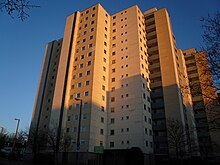Grohner dune
The Grohner Düne in Bremen - Vegesack , district Grohn , Friedrich-Klippert-Strasse / Hermann-Fortmann-Strasse / Bydolekstrasse, is a large residential complex and is one of the most important buildings in Bremen .
history
Grohn is a district of the Vegesack district with around 6,200 inhabitants. As a traditional workers' quarter, Grohn used to be predominantly characterized by small-scale housing developments.
A large residential complex with 730 units was planned on the former site of the North German stoneware factory . From 1969 to 1973 only the first and second construction phases of the large residential complex Grohner Düne on the border between Grohn and Vegesack near the Vegesack train station, the Haven Höövt shopping center and Vegesacker Hafen as well as the Weser and Lesum were realized by Bremer Treuhand . The ring-shaped, stair-like 16-storey building up to 55 meters high with 570 apartments is concentrated in a very small space. The architect was the planning department of the Bremer Treuhand. The underground car park is located under the courtyard-like interior.
In the face of the change in architectural criticism at the time, the third construction phase and other large-scale construction projects such as the Vegesacker ferry pier and Sedanplatz in Vegesack were not pursued any further. The high density and the inadequate infrastructure came under criticism: the entire district of Grohn, including the Grohner dune, has an area of only approx. Two square kilometers, which results in a population density of over 2,800 people per square kilometer.
The architecture guide bremen writes: “In the urban spatial effect of the building, the silhouette dominates above all, which staggered up like a staircase up to 16 floors - crowned by the roof heating center. The building thus exaggerates the natural topography. However, the architectural quality of the white giant bears no relation to its urban design. The completion of the first two construction phases must have seemed like a healing shock ... Seen in this way, the Grohner dune remains a warning landmark. "()
The structural change and the decline of the volcano shipyard in Vegesack caused an economic downturn. This also had a significant impact on the tenants in the Grohner Düne. This is why the residential area was already considered a district with special development needs as early as the mid-1980s .
From 1984 to 1990 improvement projects were carried out in parts of the Grohner Dune. The negative development to stop taking 1,999 Bremen plant in the municipal support program Living in Neighborhoods (WiN) and sat for Grohn a neighborhood management one. With extensive renovations from 1998/99 on, the decline of the residential complex was to be stopped. Since 2005, the district Grohn in urban development funding program Social City . The Grohner Düne remained in criticism with formulations such as: "Integration project in" Grohner Düne "failed" ( Radio Bremen from February 17, 2014), "The Grohner Düne in Bremen-Nord is a social hot spot." ( Weser-Kurier vom May 20, 2014)
After purchasing the larger part of Grohner Düne with 422 apartments, the property group Grand City Properties from Cyprus also acquired the second part of the high-rise complex with 150 apartments from a Dutch company in 2014 . The group manages all 572 apartments in this complex.
In 2014 just under 1700 people lived here, 87% of them have a migration background . The actual number of residents is estimated by the administration to be even higher due to the large number of refugees at around 2000 (2016). The Grohner Düne is still a source of conflict, where clashes between (sometimes armed) ethnic groups and family clans occur more frequently. The clear crime preventive thrust of the integration concept “Pro Dune” from 2013 was not implemented. At the beginning of 2016, the administration presented a new concept to improve the social situation, but the owner was not involved in its development. That only happened in August 2016, when the owner agreed to partial renovation.
Web links
Individual evidence
- ^ Germany: City of Bremen. Population statistics, graphs and map. In: citypopulation.de. December 31, 2018, accessed August 20, 2019 .
- ↑ Large residential complex “Grohner Düne” in the architecture guide bremen
- ↑ Patricia Brandt: Grohner Düne completely sold . In: Weser courier . May 21, 2014, ZDB ID 2532500-0 ( online [accessed on August 20, 2019]).
- ↑ Patricia Brandt: Grohner dune source of conflict . In: Weser courier . April 8, 2015, ZDB ID 2532500-0 ( online [accessed August 20, 2019]).
- ↑ Frauke Fischer: 3.5 million euros for Grohner Düne . In: Weser courier . January 13, 2016, ZDB ID 2532500-0 ( online [accessed August 20, 2019]).
Coordinates: 53 ° 10 ′ 6.7 ″ N , 8 ° 37 ′ 47.4 ″ E


